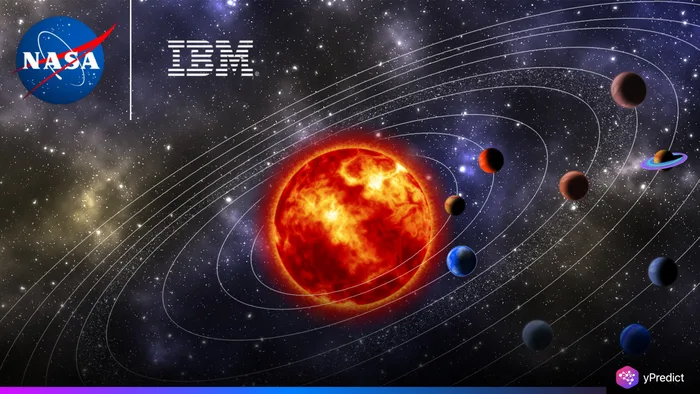
NASA and IBM launched Surya AI, an artificial intelligence system designed to improve forecasting of space weather events. The model analyzes years of solar activity data to predict dangerous eruptions that threaten life and technology on Earth. Surya AI aims to forecast events that may impact satellites, power grids, and critical technologies on the ground. This system introduces advanced tools to help prevent disruptions caused by the Sun’s unpredictable behavior.
The collaboration shows how machine learning combines with space science to solve global challenges. Surya AI, trained with nine years of Solar Dynamics Observatory data, already delivers 16% higher forecasting accuracy. It offers more than innovation, serving as a shield for astronauts, a stabilizer for communication, and a support for future space missions.
Why Solar Storms Pose a Global Threat
Solar flares and coronal mass ejections expel charged particles and magnetic energy which propagate through the solar system. When these events happen regularly or are especially intense, they can disrupt modern infrastructures. For example, satellites may fail which enable communications, navigation, and aviation routes; global positioning systems can be compromised in ways that put lives and infrastructures at risk; and, in larger storms, even power grids can overload and shut down.
Astronauts are particularly susceptible to dangers created by solar radiation that comes with solar eruptions – it’s possible that the energy from the particles will affect human health, and ultimately mission plans. As NASA moves forward with plans for lunar bases, followed by potential human exploration of Mars, having a good understanding of solar storm activity is not merely a fascinating scientific problem, it is an essential consideration for society in general, and human exploration in particular.
How Surya AI Strengthens Solar Forecasting
Surya AI interprets significant amounts of solar data by utilizing a process of machine learning. Surya AI does not use limited physical models and traditional methods that rely on physical models. The program takes large streams of imagery and solar magnetic readings and finds small indicators of instability.
The training data for Surya AI comes from NASA’s Solar Dynamic Observatory (SDO), which launched in 2010, and which provided images every 12 seconds in multiple wavelengths, as well as detailed mapping of the magnetic field. The SDO dataset is unique in that it allows for real time forecasting of space weather. Surya’s training was done over a full solar cycle, allowing Surya the consistency to associate patterns that are otherwise difficult.
Accuracy and Early Forecasting Capabilities
Preliminary findings have shown that Surya AI produces a 16% performance improvement over the current forecasting methods. Surya can provide visual predictions two hours in advance which gives satellite operators and power managers vital time for action. Even a small extra warning can help mitigate the risk of cascading failures in global systems.
Surya AI also provides dynamic visualizations which add different ways of representing forecasts that scientists and engineers would find appealing and easier to interpret. Presenting predictions as visual components organizes data science with actionable decision-making.
NASA Makes Surya AI Open-Source for Global Research
In a bid to speed up innovation, NASA has made their Surya AI open-source. Researchers can interact with the model on Hugging Face and review the code on GitHub. NASA is hoping this will facilitate stronger collaboration between governments, universities, and industry partners worldwide. By enabling the model and code for download and use, NASA can now, according to its vision, ensure that solar storm prediction will positively impact all corners of the earth.
Industry partners, such as IBM and NVIDIA, also assisted the development of Surya AI in terms of hardware and optimization. And the use of the National AI Research Resource helped provide the computing power needed to assist in the collaboration and vision. This project demonstrates and amplifies the importance of public and private partnerships, for the betterment of space defense.
The Broader Impact of AI in Space Weather Forecasting
Surya AI’s impact goes beyond satellites and spacecraft. Military defense, finance, internet systems, and aviation safety all depend on stable communication networks. Solar disruptions threaten these networks, so businesses and governments prioritize protecting them to maintain global stability.
Heliophysics has advanced rapidly, and Surya AI marks a major leap forward in this progress. It mirrors how meteorology advanced storm and climate predictions. Surya AI aims to make daily space weather forecasts as reliable as Earth-based ones. This reliability will build preparedness and resilience across industries for future space weather challenges.
NASA’s Vision for the Future
NASA officials say that Surya AI is just the beginning as they are embedding deep expertise in science into advanced AI systems to create powerful models that could predict not only solar storms, they could predict larger cosmic conditions.
Kevin Murphy, NASA’s Chief Science Data Officer referred to the initiative as a step toward data driven science. Joseph Westlake, Director of NASA’s Heliophysics Division noted that meteorology redefined life on Earth and that protecting astronauts, spacecraft and the implications for technology on Earth to the future will become increasingly important as humanity extends deeper into space.






